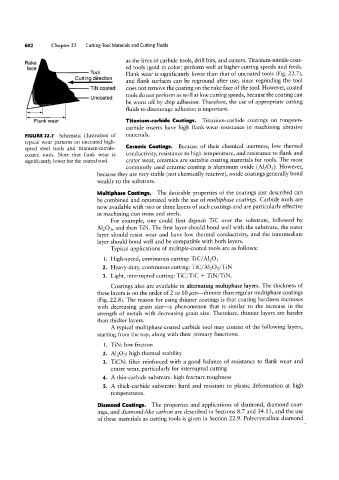Page 621 - 04. Subyek Engineering Materials - Manufacturing, Engineering and Technology SI 6th Edition - Serope Kalpakjian, Stephen Schmid (2009)
P. 621
602 Chapter 22 Cutting-Tool Materials and Cutting Fluids
as the lives of carbide tools, drill bits, and cutters. Titanium-nitride-coat-
Rake
face ed tools (gold in color) perform well at higher cutting speeds and feeds.
T°f9| Flank wear is significantly lower than that of uncoated tools (Fig. 22.7),
Cuttlng direction
and flank surfaces can be reground after use, since regrinding the tool
TiN coated does not remove the coating on the rake face of the tool. However, coated
tools do not perform as well at low cutting speeds, because the coating can
Uncoated
be worn off by chip adhesion. Therefore, the use of appropriate cutting
fluids to discourage adhesion is important.
Flank wear Titanium-carbide Coatings. Titanium-carbide coatings on tungsten-
carbide inserts have high flank-wear resistance in machining abrasive
FIGURE 22.1 Schematic illustration of fI121f€1”i6llS-
typical wear patterns on uncoated high-
speed steel tools and titanium-nitride- Ceramic Coatings. Because of their chemical inertness, low thermal
Coated fO01S_ Note that flank Wear is conductivity, resistance to high temperature, and resistance to flank and
significantly lower for the coated tool. crater wear, ceramics are suitable coating materials for tools. The most
commonly used ceramic coating is aluminum oxide (Al2O3). However,
because they are very stable (not chemically reactive), oxide coatings generally bond
weakly to the substrate.
Multiphase Coatings. The desirable properties of the coatings just described can
be combined and optimized with the use of multiphase coatings. Carbide tools are
now available with two or three layers of such coatings and are particularly effective
in machining cast irons and steels.
For example, one could first deposit TiC over the substrate, followed by
AIZO3, and then TiN. The first layer should bond well with the substrate, the outer
layer should resist wear and have low thermal conductivity, and the intermediate
layer should bond well and be compatible with both layers.
Typical applications of multiple-coated tools are as follows:
I. High-speed, continuous cutting: TiC/A1203
2. Heavy-duty, continuous cutting: TiC/ A1203/ TiN
3. Light, interrupted cutting: TiC/TiC + TiN/ TiN.
Coatings also are available in alternating multiphase layers. The thickness of
these layers is on the order of 2 to 10 /im-thinner than regular multiphase coatings
(Fig. 22.8). The reason for using thinner coatings is that coating hardness increases
with decreasing grain size-a phenomenon that is similar to the increase in the
strength of metals with decreasing grain size. Therefore, thinner layers are harder
than thicker layers.
A typical multiphase-coated carbide tool may consist of the following layers,
starting from the top, along with their primary functions:
I. TiN: low friction
2. Al2O3: high thermal stability
3. TiCN: fiber reinforced with a good balance of resistance to flank wear and
crater wear, particularly for interrupted cutting
4. A thin-carbide substrate: high fracture toughness
5. A thick-carbide substrate: hard and resistant to plastic deformation at high
temperatures.
Diamond Coatings. The properties and applications of diamond, diamond coat-
ings, and diamond-like carbon are described in Sections 8.7 and 34.13, and the use
of these materials as cutting tools is given in Section 22.9. Polycrystalline diamond

